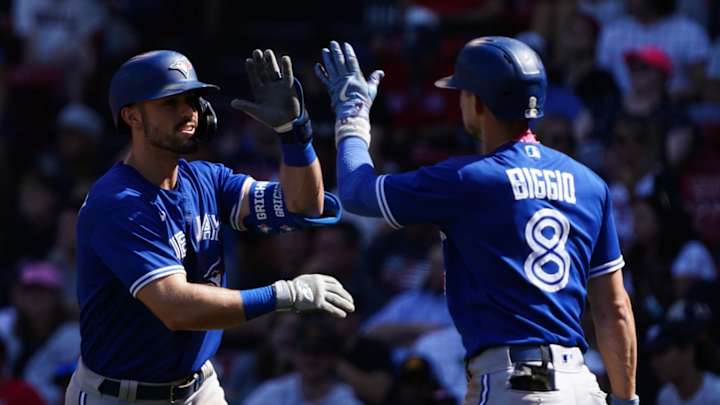Which Blue Jays Hitters Are Most Impacted by MLB Banning the Shift?

As MLB owners continue to exchange proposals with the players' camp in hopes of reaching a new collective bargaining agreement, the Players Association is reportedly willing to cede some power regarding rule changes in the coming years.
According to MLB Network reporter Jon Heyman, the players union agreed, in principle, to allow MLB to implement a pitch clock, increase the size of bases, and ban the shift starting in 2023.
The league has long eyed banning the shift as a method to increase defensive activity and add more excitement to the game.
It’s unclear how exactly the shift ban will be applied, though it’s possible all four infielders will be required to keep two feet on the dirt before each play—which is currently a rule in Double A—or only two infielders will be allowed on either side of second base.
Regardless of its application, a ban on the shift will affect how every team approaches the game, some more than others. The Blue Jays don’t shift on defense anywhere near as often as the Dodgers do (53%, tops in MLB in 2021), but they still used it for a good chunk of at-bats last year.
While the rule change won’t happen until 2023, here’s how Toronto’s current roster is impacted by a ban on defensive shifts.

Cavan Biggio
No one on the current Blue Jays roster faced the shift in a higher percentage of at-bats than Biggio (62%).
When he debuted in 2019, Biggio, a left-handed hitter, was essentially a dead-pull guy who generated all kinds of power from turning on balls and yanking them towards the right-field corner.
Since defenses started dropping an infielder into deep right field, the 26-year-old has been forced to use the middle of the diamond more, and his power has suffered because of it. In his rookie season, Biggio slugged .825 on balls he pulled; he’s not come close to that mark in the following two seasons.
A ban on shifting allows Biggio to swing away and hit to his strengths, which, when combined with his stellar plate discipline, could make him much more dangerous at the plate in a few years.
Randal Grichuk
Grichuk struggled to hit through the shift in 2021, managing just a .259 average on balls in play. Defenses used a traditional right-handed hitter shift against him—three men on the left side of second base—and it neutralized his ability to get on base.
For Grichuk, the proof is in the spray charts. Since he debuted in 2014, 52% of the balls he pulled were hit on the ground, which, in theory, should make him extra vulnerable to the shift.
Since Fangraphs only counts shift data for balls put in play, Grichuk has a career .670 OPS when he’s facing a shift. Without a shift, his OPS rises slightly to .709.
It’s likely a pull-heavy hitter like Grichuk benefits from a ban on shifts, but his overall contact woes don’t make this rule change influence his numbers as much as one might think.
Danny Jansen/Alejandro Kirk
Although in a small sample size, Jays catchers Alejandro Kirk and Danny Jansen struggled against a shifted defense, batting just .172 and .208 on balls in play, respectively.
For Kirk, the data is straightforward. He hits the ball up the middle at a 41% clip, according to Baseball Savant, three percent higher than the MLB average. Defenses countered that by stationing an infielder directly behind second base where grass meets dirt. A rule change removing that up-the-gut defender would greatly benefit Kirk.
In contrast, Jansen is a wicked pull-hitter who, in his career, pulls the ball 47% of the time, 10% higher than league average. He’s simply a better hitter when he swings like that, too, which was illustrated by his seven percent increase in pulled balls during his torrid stretch at the plate in September 2021.
The math for Jansen is easy—he bats .277 on balls in play without the shift, but just .195 when the shift is on. His style of hitting would significantly benefit from a shift ban.
Teoscar Hernandez/Bo Bichette
For Hernández, this may be a rare case where a shift ban works against him. The 29-year-old reinvented himself at the dish in 2021 by limiting strikeouts and hitting the ball the opposite way 26% of the time, three percent higher than in 2020.
Hernández exploited shifted defenses last season, but a ban on shifting could see those ground balls through the right side get gobbled up in the future.
Bichette, being the statistic anomaly he often is, was shifted in a minuscule percentage of his at-bats, yet managed to hit .390 on balls in play when facing the shift last season.
These statistics suggest Bichette and Hernández are better hitters versus a shifted defense than a non-shifted defense, though the data is more a testament to the duo’s BABIP abilities, a stat they both finished in the league's top-20 last season.
Blue Jays team defense
It’s worth addressing how the shift ban will also impact the Blue Jays on defense. According to Baseball Savant, Toronto shifted on just 25% of total plate appearances in 2021, below the league average of 31%.
The Blue Jays did, however, shift their defense 54% of the time against left-hander hitters, and even employed the four-man outfield late in the season against sluggers like the Yankees’ Joey Gallo and the Twins’ Jorge Polanco.
Other than Santiago Espinal, the Blue Jays don’t have a ton of rangy defenders, meaning the rule change may force Toronto’s infielders to cover significantly more ground.
